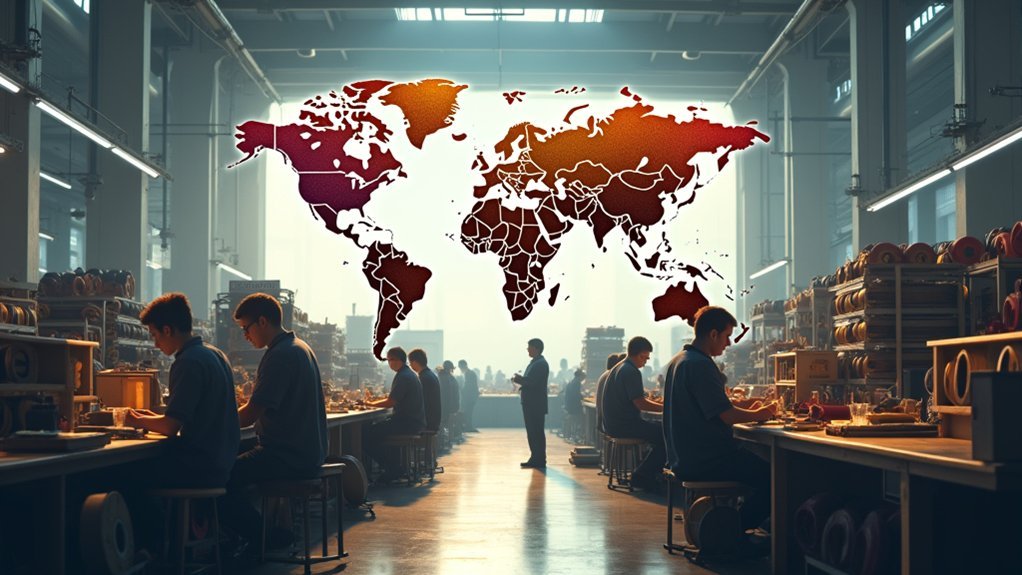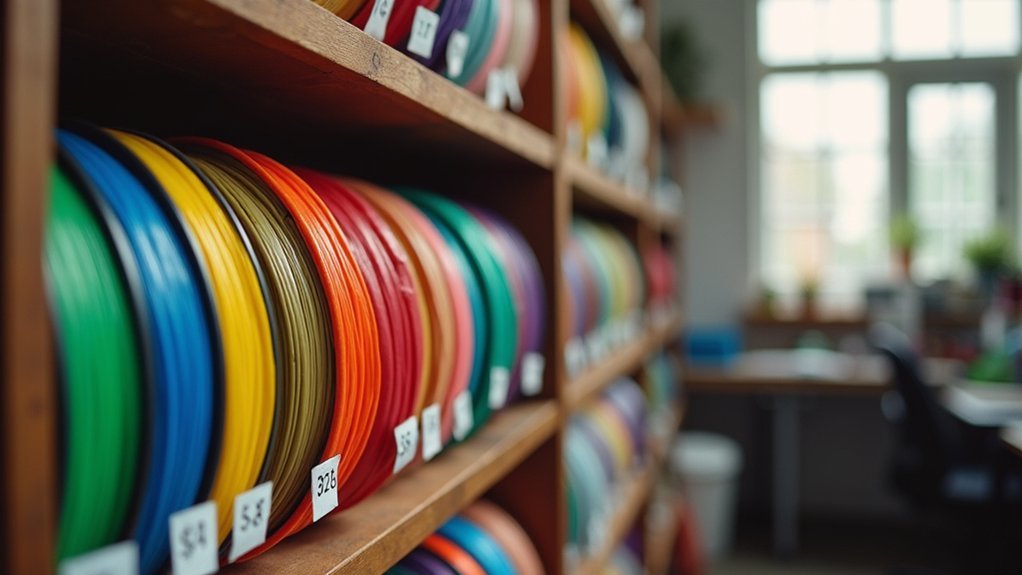You’ll find 3D printer filament prices vary wildly because they’re influenced by raw material quality, manufacturing complexity, and brand reputation. Premium polymers like engineering-grade materials cost considerably more than basic PLA due to specialized production processes and strict quality control. Geographic location affects labor costs, while supply chain disruptions, currency fluctuations, and market demand create additional price volatility. Environmental compliance and additive components further impact costs, making filament pricing a complex ecosystem with multiple variables that we’ll explore further below.
Raw Material Quality and Polymer Composition

Quality forms the foundation of filament pricing, where the raw materials you choose directly impact both performance and cost. When filament manufacturers use superior polymers, you’ll notice higher prices that reflect enhanced durability and performance.
The polymer composition itself plays a vital role—PLA costs less due to its renewable sourcing, while ABS and specialty polymers like PETG command premium prices for their advanced properties.
Raw material quality becomes evident in the final product’s reliability. Lower-grade materials containing impurities can cause cracking and leaking, making them poor investments despite cheaper upfront costs.
Poor quality filament with impurities leads to cracking and leaking, making it a costly mistake despite initial savings.
Engineering polymers require complex manufacturing processes and strict quality control, explaining why brands like Filamentive PRO cost more. You’re fundamentally paying for consistent performance and reduced printing failures.
Additive Components and Color Variations
Beyond the base polymer itself, additive components represent another major cost driver in 3D printing filament prices. When you’re choosing filaments, you’ll notice significant price differences that often stem from the quality and complexity of additives used. High-end dyes, including fluorescent and UV-active variants, command premium prices due to their superior performance characteristics.
| Additive Type | Price Impact | Quality Effect |
|---|---|---|
| Basic dyes | Low | Standard color |
| Fluorescent dyes | High | Enhanced visibility |
| UV-active compounds | Very High | Special properties |
Color variations require different additive formulations, with complex colors costing more to produce. Small amounts of specific additives can dramatically enhance properties like hardness and flexibility. However, lower-quality additives containing impurities can cause cracking or leaking, making quality investment essential for reliable performance.
Manufacturing Process and Quality Control Standards

When manufacturers invest in specialized extrusion equipment and precise calibration systems, these costs directly translate to higher filament prices you’ll encounter at retail.
The manufacturing process requires sophisticated machinery that maintains uniformity and consistency throughout production. Quality control standards separate premium brands from budget alternatives—companies like Filamentive test every batch to guarantee performance, while cheaper manufacturers skip these verification steps.
Higher-grade raw materials command premium prices, as quality polymers and additives enhance filament properties notably.
Rigorous testing procedures include laser measurement during extrusion to maintain tight tolerances.
- Gleaming steel extruders humming as molten polymer flows through precision-calibrated dies
- Digital calipers measuring filament diameter hundreds of times per minute
- Laboratory technicians analyzing sample spools under bright fluorescent lights
Brand Reputation and Market Positioning
Brand reputation acts as a powerful pricing lever in the 3D printing filament market, where established manufacturers like Filamentive can charge premiums that budget competitors simply can’t justify.
You’ll find that well-known brands leverage their proven track record for quality and reliability, making consumers willing to pay extra for trusted printer filament.
Filamentive’s British heritage particularly resonates with UK buyers, as 88% will pay more for locally-made products.
Their market positioning emphasizes sustainability and ethical practices, aligning with consumer values to support higher pricing.
The limited number of established manufacturers creates favorable conditions for premium brand reputation strategies.
When you choose reputable brands, you’re paying for rigorous quality control and tighter tolerances that justify the cost difference.
Geographic Production Location and Labor Costs

Geographic production location creates dramatic price disparities across the global filament market, where manufacturers in low-cost regions like China can leverage minimum wages of approximately $376 monthly compared to Europe’s nearly $1,000 euros.
You’ll find that labor costs directly impact your filament prices, as European producers face stricter regulations and higher quality standards that increase manufacturing expenses.
American manufacturers maintain competitive pricing through domestic sourcing strategies, despite higher operational costs.
However, shipping costs from distant production facilities can offset initial savings from cheaper labor.
- Towering factory smokestacks rising from sprawling Chinese industrial complexes churning out affordable filament spools
- Pristine European manufacturing facilities with workers in clean uniforms operating precision equipment under strict quality protocols
- American production lines humming efficiently with locally-sourced materials reducing dependency on costly international shipping
Packaging Materials and Sustainability Features
When you’re shopping for filament, you’ll notice that spool materials notably impact pricing beyond just the plastic itself.
Traditional plastic spools are cheaper to produce, but many manufacturers are switching to cardboard alternatives that cost more due to higher production complexity and smaller market competition.
You’ll pay premium prices for eco-friendly packaging features, as sustainable cardboard spools can add substantial costs that manufacturers pass directly to consumers.
Spool Material Costs
While you might overlook the spool holding your filament, its material greatly impacts the final price you’ll pay. Traditional plastic spools are being replaced by sustainable cardboard alternatives, but this shift comes with spool material costs that manufacturers pass onto consumers.
Cardboard spools cost more to produce due to smaller market size and less competition compared to standard plastic options.
When you choose filament with eco-friendly practices, you’re paying a premium for sustainable packaging. Brands like Filamentive offer 100% recyclable cardboard spooling, but the increased production costs and labor intensity translate to higher prices.
Consider these cost factors:
- Cardboard spools require more complex manufacturing processes
- Limited suppliers create pricing bottlenecks for sustainable materials
- Environmental compliance adds regulatory overhead expenses
Eco-Friendly Packaging Premiums
Beyond spool materials, eco-friendly packaging features substantially increase your filament costs through specialized protective materials and sustainable printing processes. You’ll pay premiums for cardboard spools because they’re more labor-intensive to produce and manufactured in smaller, less competitive markets. Companies like Filamentive offer 100% recyclable cardboard spooling that minimizes environmental impact but costs more than traditional plastic alternatives.
| Packaging Type | PLA Filament Cost | PETg Filament Cost | Environmental Impact |
|---|---|---|---|
| Standard Plastic Spool | $25-30/kg | $35-40/kg | High waste |
| Recycled Plastic Spool | $28-33/kg | $38-43/kg | Medium waste |
| Cardboard Spool | $32-38/kg | $42-48/kg | Low waste |
You’re increasingly willing to pay these premiums as sustainability becomes prioritized in 3D printing, making eco-friendly packaging a significant cost factor.
Distribution Channels and Reseller Markups
Although manufacturers often sell filament directly to consumers, the distribution channel you choose greatly impacts the price you’ll pay. When buying filament through resellers, you’re encountering distribution channels that add markups for profit. These intermediaries purchase at discounted wholesale rates, then increase prices based on demand and availability.
Distribution channels significantly influence filament pricing as resellers add profit-driven markups between manufacturers and consumers.
The niche 3D printing market’s limited competition allows resellers significant pricing flexibility. They’ll adjust costs according to trends and fluctuations, while regional sellers often offset high shipping expenses through strategic pricing.
- Picture walking into a local shop where shelves display colorful spools at premium prices.
- Imagine clicking “add to cart” on international websites with varying currency conversions.
- Visualize comparing identical filaments priced differently across multiple online stores.
Understanding reseller markups helps you navigate these distribution channels more effectively.
Currency Exchange Rate Fluctuations
You’ll notice that currency exchange rate fluctuations can dramatically affect your filament costs, with the same product showing significant price differences between regions—like Filamentum’s PLA Extrafill priced at 21.00 EUR versus 33.99 USD for identical spools.
These regional price disparities create opportunities for savvy buyers who monitor exchange rates and can time their purchases strategically.
You can potentially save money by purchasing from suppliers in different currencies when exchange rates work in your favor, though you’ll need to factor in shipping costs and delivery times.
Exchange Rate Impact
When purchasing filament from international suppliers, currency exchange rate fluctuations can dramatically alter your final costs, often creating significant price disparities between regions.
These exchange rates directly impact what you’ll pay, sometimes making identical products cost vastly different amounts depending on your location and payment currency.
Consider these real-world examples of how currency affects filament prices:
- colorFabb’s ECONOMY BLACK PETG costs €48.40 in Europe but $54.73 in the US market
- Filamentum’s PLA Extrafill Chocolate Brown jumps from €21.00 to $33.99 due to exchange rate impacts
- Prusa’s PETG Jet Black shows potential savings at 578 CZK versus $29.99 USD
Shipping costs often amplify these currency-driven price differences, making international purchases even more expensive when exchange rates work against you.
Regional Price Disparities
Exchange rate fluctuations create stark regional price disparities that extend far beyond simple currency conversion, fundamentally reshaping how much you’ll actually pay for identical filament products across different markets.
You’ll notice significant differences when comparing prices globally. Filamentum’s PLA Extrafill Chocolate Brown demonstrates this perfectly – it converts to USD 23.74 from EUR 21.00, yet US customers pay USD 33.99 for the identical product.
These are key factors that affect your purchasing decisions for Printing Filaments. Currency timing matters too; Prusament’s PETG Jet Black converts to just USD 24.53 when purchased in CZK.
However, shipping costs often eliminate potential savings, making imported filaments expensive despite favorable exchange rates, particularly impacting consumers in markets with limited local manufacturing.
Multi-Currency Purchasing Strategies
Strategic currency shopping can dramatically reduce your filament costs if you time purchases with favorable exchange rate movements and understand the true cost implications beyond simple conversions.
You can save quite a bit by purchasing directly from European manufacturers when the EUR weakens against your local currency. Prusa Research’s PETG Jet Black demonstrates this perfectly – priced at $29.99 USD versus 578 CZK, creating opportunities for savvy buyers.
However, you’ll need to factor in shipping costs that can erode savings. Filamentum’s PLA costs 21.00 EUR (23.74 USD) locally but retails for 33.99 USD domestically due to shipping fees.
- Monitoring currency fluctuations like a day trader watching stock prices
- Calculating total costs including hidden shipping fees and import duties
- Timing bulk purchases when exchange rates favor your wallet
Tariff Policies and Trade Regulations
Although tariff policies aim to protect domestic manufacturers, they directly impact your wallet when purchasing 3D printing filaments.
You’ve likely noticed companies like Polymaker implementing 10% price hikes starting May 1st, directly attributing these increases to tariff policies. The government’s strategy creates a ripple effect where you’ll face higher costs as companies pass these expenses onto buyers.
However, you’ll find domestic manufacturers like Polar Filament maintain stable pricing thanks to their domestic supply chains.
While imported PETG filament costs around $8/kg, tariff-induced increases make American options more competitive despite higher base prices.
You can navigate these challenges by considering regional sourcing, as the combination of tariffs and shipping costs makes local suppliers increasingly attractive for cost-conscious purchases.
Supply Chain Disruptions and Inventory Management
You’ll notice that global shipping delays can greatly impact your filament costs, as manufacturers struggle to receive raw materials on time.
When raw material shortages occur, you’re likely to see price spikes as suppliers compete for limited resources.
Your local retailer’s warehouse stock fluctuations directly affect availability, often forcing you to pay premium prices when inventory runs low.
Global Shipping Delays
When global shipping networks face disruptions, 3D printing filament prices inevitably surge as supply chains struggle to meet consistent demand.
You’re witnessing firsthand how COVID-19 exposed critical vulnerabilities in international logistics, creating extensive delays that manufacturers can’t easily overcome.
These disruptions force companies to absorb higher shipping costs and longer lead times, expenses they’ll inevitably pass on to you.
Tariffs on imported goods compound these challenges, adding another layer of cost that drives prices even higher.
You’ll notice manufacturers struggling with inconsistent raw material availability, making it nearly impossible to maintain steady production schedules.
- Container ships stacked like toys at congested ports, waiting weeks to unload
- Empty warehouse shelves where colorful spools once lined organized rows
- Frustrated makers refreshing shipping tracking pages showing “delayed indefinitely”
Raw Material Shortages
Raw material shortages strike at the heart of filament manufacturing, creating ripple effects that directly impact your wallet. When manufacturers can’t secure essential polymers, production costs skyrocket, and those increases get passed directly to you.
Global events like natural disasters or geopolitical tensions can suddenly choke off raw material supplies, causing dramatic price swings you’ll feel immediately.
Your filament costs become especially volatile when manufacturers rely heavily on single suppliers or maintain minimal inventory. If their preferred source gets disrupted, there’s nowhere else to turn quickly.
However, you’ll notice more stable pricing from manufacturers who’ve diversified their supplier networks and stockpiled materials. These companies can weather supply storms better, keeping your project costs more predictable even when global markets face serious disruptions.
Warehouse Stock Fluctuations
Beyond raw material availability, inventory decisions at filament warehouses create another layer of price uncertainty that hits your budget hard.
When supply chain disruptions delay shipments or production issues arise, you’ll face temporary shortages that drive prices up quickly. Manufacturers can’t maintain steady pricing with fluctuating stock levels – they’ll raise prices when inventory runs low to balance demand with limited supply.
Seasonal peaks make things worse. During holiday rushes, you’re competing with other makers for dwindling stock, forcing prices higher. International shipping delays and tariffs further complicate availability, especially for imported filaments.
- Empty warehouse shelves forcing desperate customers to pay premium prices
- Holiday shopping frenzies creating bidding wars over remaining spools
- Shipping containers stuck at ports while printer enthusiasts wait anxiously
Market Demand and Production Volume Economics
Because the 3D printing filament market operates with high demand but relatively low production volumes, manufacturers can maintain elevated prices with limited competitive pressure.
When you’re shopping for filament, you’ll notice prices spike whenever 3D printing gains mainstream attention or new applications emerge. This happens because production capacity can’t quickly scale to meet sudden demand surges.
You’re fundamentally dealing with a market where manufacturers control supply while you and other customers compete for limited inventory.
The economics work against you as a consumer – when everyone wants filament simultaneously, producers don’t need to lower prices to attract buyers. Instead, they’ll raise them because they know you’ll pay more when alternatives are scarce.
When demand peaks, filament producers raise prices instead of competing for customers because they know you’ll pay more.
This demand-supply imbalance creates the price volatility you experience when purchasing filament.
Environmental Standards and Regulatory Compliance
When manufacturers face stricter environmental regulations, they’ll pass those compliance costs directly to you through higher filament prices. Companies investing in cleaner production technologies and waste disposal systems must recoup these expenses somehow.
You’ll notice bio-based and recycled filaments often cost more because they require specialized manufacturing processes that meet higher environmental standards.
- Picture a manufacturing facility installing expensive emission control systems with towering smokestacks fitted with advanced filtration technology.
- Visualize workers in a clean room carefully sorting colorful plastic waste into precise categories for recycling into premium eco-friendly filaments.
- Imagine certification inspectors reviewing detailed documentation while examining production equipment with clipboards and testing instruments.
Sustainability-focused brands charge premium prices to cover certification processes and maintain their eco-friendly commitments, making environmentally responsible filaments costlier options.
Frequently Asked Questions
Why Are Filaments so Expensive?
You’re paying premium prices because filaments require high-quality polymers, specialized manufacturing processes, and rigorous quality control. Limited production volumes, brand reputation, regional labor costs, and tariffs all contribute to expensive pricing.
Why Does PLA Cost More Than PETG?
You’ll pay more for PLA because it’s made from renewable resources like cornstarch, requires complex processing, stringent quality control, and commands premium pricing due to growing consumer demand for eco-friendly materials.
How to Calculate the Cost of Filament?
You’ll calculate filament cost by starting with the base price per kilogram, then adding shipping, packaging costs, and any additives. Don’t forget to subtract bulk purchase discounts if applicable.
Will Tariffs Affect Filament Prices?
Yes, tariffs will increase your filament costs. You’ll see companies like Polymaker raising prices by 10% due to import tariffs, though some imported options may still remain competitively priced.





Leave a Reply